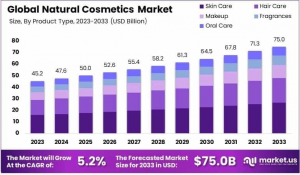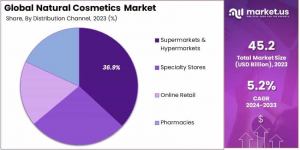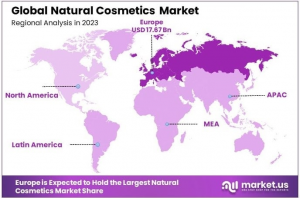Natural Cosmetics Market Set to Reach USD 75.0 Billion by 2033, Steady Growth with a 5.2% CAGR
Natural Cosmetics Market size is expected to be worth around USD 75.0 Bn by 2033, from USD 45.2 Bn in 2023, growing at a CAGR of 5.2% during forecast period.
According to a report by Market.us, the Global Natural Cosmetics Market is projected to reach a valuation of approximately USD 75.0 Billion by 2033, expanding from USD 45.2 Billion in 2023. This growth is anticipated to occur at a compound annual growth rate (CAGR) of 5.2% during the forecast period from 2024 to 2033.
The natural cosmetics sector encompasses personal care products formulated primarily with natural ingredients such as plant extracts, minerals, and essential oils, positioning themselves as safer and healthier alternatives to conventional cosmetics laden with synthetic chemicals. This market expansion is fueled by increasing consumer demand for sustainable and clean beauty solutions, driven by heightened awareness of the potential health risks associated with synthetic additives like parabens, phthalates, and formaldehyde.
A significant factor contributing to this trend is the growing preference for products that emphasize transparency, ethical sourcing, and environmentally friendly packaging. Additionally, regulatory support plays a crucial role, with numerous U.S. states introducing legislation aimed at reducing toxic chemicals in personal care products. Despite the robust growth prospects, the market remains moderately saturated, with established brands, startups, and niche players fiercely competing on factors such as product quality, innovation, and ethical marketing practices.
Consumer behavior trends, such as a strong preference for experiential retail engagement, particularly in physical stores, further influence market dynamics. As the industry evolves, brands are increasingly focusing on leveraging digital platforms and influencer partnerships to enhance visibility and engage with a broader audience, thereby sustaining brand loyalty and driving continued market growth.
➥Tap into Market Opportunities and Stay Ahead of Competitors - Get Your Sample Report Here: https://market.us/report/natural-cosmetics-market/request-sample/
Key Takeaways
- The Natural Cosmetics Market, valued at USD 45.2 Billion in 2023, is expected to surge to USD 75.0 Billion by 2033, reflecting a steady CAGR of 5.2% over the forecast period.
- In 2023, the Skincare segment dominated the market with a 36.5% share, propelled by heightened consumer awareness regarding skin health and the proliferation of natural ingredients.
- Women represented the largest end-user group in 2023, accounting for 40.5% of the market, driven by their predominant role in personal grooming and higher expenditure on toiletries.
- Supermarkets and Hypermarkets led the distribution channels in 2023 with a 36.9% market share, favored for their extensive product range and accessibility.
- Europe maintained the leading regional position with a 39.1% market share in 2023, underscored by strong demand for sustainable and eco-friendly beauty products.
- Organic formulations dominated the product formulation segment, reflecting consumers' preference for health benefits and environmental sustainability.
Regional Analysis
Europe dominates the Global Natural Cosmetics Market with a commanding 39.1% share, valued at USD 17.67 Billion. This leadership is attributed to the region’s robust consumer demand for clean, organic, and sustainable beauty products, reinforced by stringent regulatory standards governing cosmetic ingredients. European consumers exhibit high awareness of health and environmental issues, driving the preference for eco-friendly and cruelty-free products. The presence of a mature cosmetics industry, encompassing both local and international brands, further propels market growth.
Additionally, the burgeoning wellness trends and the adoption of natural skincare routines among diverse consumer groups contribute to Europe’s dominant market position. Investment in research and development within the region fosters innovation in plant-based products and sustainable packaging solutions, catering to the evolving demands of conscious consumers. The region’s emphasis on sustainable sourcing and ethical practices enhances consumer trust and brand loyalty, ensuring sustained market growth.
Furthermore, Europe’s strategic initiatives to promote natural cosmetics through government support and industry collaborations bolster its leading stance in the global market. As environmental sustainability and health consciousness continue to influence consumer behavior, Europe is well-positioned to maintain its leadership, driven by continuous advancements in product formulations and a strong focus on sustainability.
Report Segmentation
Product Type
The Product Type segment of the Natural Cosmetics Market is categorized into Skin Care, Hair Care, Makeup, Fragrances, and Oral Care. Among these, Skin Care leads the market with a 36.5% share, driven by increasing consumer awareness of skin health and the benefits of natural ingredients. Products such as moisturizers, serums, and cleansers made from organic and botanical components are highly sought after for their effectiveness and gentle impact on the skin. Hair Care follows, encompassing natural shampoos, conditioners, and treatments that address common hair issues like dandruff and dryness without harsh chemicals.
Makeup products, including natural foundations, lipsticks, and mascaras, are gaining popularity as consumers seek products that offer both aesthetic appeal and skin benefits. Although smaller in size, the Fragrances segment plays a crucial role by offering eco-friendly and personalized scents derived from essential oils. Oral Care products, such as natural toothpaste and mouthwashes, are also expanding, appealing to health-conscious consumers prioritizing oral hygiene with safe, natural ingredients. This diverse segmentation allows the market to cater to a wide range of consumer preferences and needs, fostering sustained growth across all product categories.
Formulation
The Formulation segment is divided into Organic, Vegan, and Cruelty-Free categories, with Organic formulations leading the market due to their perceived health benefits and commitment to environmental sustainability. Organic cosmetics are crafted from ingredients cultivated without synthetic pesticides, fertilizers, or GMOs, resonating with consumers who prioritize purity and sustainability.
Vegan formulations cater to the growing demographic that avoids animal-derived ingredients and seeks cruelty-free products, aligning with ethical consumerism trends. Cruelty-Free formulations emphasize the absence of animal testing, appealing to consumers advocating for animal rights and ethical treatment.
This segmentation reflects the diverse preferences of modern consumers who seek products that not only meet their beauty needs but also align with their ethical and environmental values. The emphasis on natural, ethically sourced ingredients and sustainable practices across these formulations drives innovation and differentiation within the market, enabling brands to effectively meet the evolving demands of a conscientious consumer base.
End-User
The End-User segment encompasses Men, Women, and Unisex categories, with Women accounting for the largest share at 40.5%. This dominance is attributed to women’s significant role in personal grooming and higher expenditure on toiletries. Women are the primary purchasers of personal care products for household use, driving higher consumption rates of skincare, hair care, and bath essentials.
The rising acceptance of personal grooming among Men has led to an increase in demand for specialized products such as skincare, shaving, and beard care items. This shift is supported by targeted marketing campaigns and the introduction of products tailored to men’s unique grooming needs. Unisex products cater to consumers seeking gender-neutral options, driven by a desire for simplicity and inclusivity in personal care routines. The versatility and broad appeal of unisex products enhance their market presence, catering to a diverse audience and supporting sustained growth within this segment.
Price Range
The Price Range segment is categorized into Low, Medium, and High, with the Medium price range dominating the market at 43.2%. This dominance is driven by consumers’ desire to balance quality and affordability, making medium-priced products the most attractive option for a broad audience.
Medium-priced natural cosmetics offer high-quality ingredients and effective formulations without the premium cost associated with high-end brands, making them accessible to a larger consumer base, including budget-conscious individuals. Low-priced natural cosmetics cater to price-sensitive consumers who seek affordable beauty solutions without necessarily compromising on natural ingredients, particularly appealing to younger consumers and those new to natural cosmetics.
High-priced natural cosmetics represent a smaller yet significant segment, targeting consumers willing to pay a premium for luxury and exclusive products. These products often feature rare and high-quality ingredients, advanced formulations, and sophisticated packaging, appealing to consumers who prioritize indulgence and superior performance in their beauty routines. This diverse pricing strategy enables the market to cater to varying consumer preferences and financial capabilities, fostering inclusive growth across all price segments.
Distribution Channel
The Distribution Channel segment includes Supermarkets and Hypermarkets, Specialty Stores, Online Retail, and Pharmacies. Supermarkets and Hypermarkets lead with a 36.9% market share, driven by their wide accessibility and extensive product range. These large retail outlets provide a convenient shopping experience, allowing consumers to browse a variety of natural cosmetics alongside their everyday grocery needs. Specialty Stores play a significant role by offering expert advice and a curated selection of high-quality products, catering to consumers seeking personalized and tailored beauty solutions.
Online Retail is rapidly gaining traction, driven by the convenience and extensive product offerings it provides. E-commerce platforms enable consumers to access a wide range of natural cosmetics from the comfort of their homes, often at competitive prices, and facilitate global market penetration. Pharmacies also contribute to the distribution of natural cosmetics by offering a trusted environment for consumers to purchase personal care products, ensuring product safety and efficacy. The strategic placement of natural cosmetics across these diverse distribution channels enhances market reach and accessibility, supporting sustained growth and consumer engagement.
➥ Secure Your Complete Report Today with a 30% Price Cut! @ https://market.us/purchase-report/?report_id=131176
Market Segmentation
By Product Type:
- Skin Care
- Hair Care
- Makeup
- Fragrances
- Oral Care
By Formulation:
- Organic
- Vegan
- Cruelty-Free
By End-User:
- Men
- Women
- Unisex
By Price Range:
- Low
- Medium
- High
By Distribution Channel:
- Supermarkets/Hypermarkets
- Specialty Stores
- Online Retail
- Pharmacies
Driving Factors
The Natural Cosmetics Market is propelled by growing consumer awareness about the harmful effects of synthetic chemicals on health and the environment. Increasing demand for organic, vegan, and cruelty-free products reflects broader trends in sustainability and ethical consumerism. Rising disposable incomes and the growing influence of social media and beauty influencers further drive the market as consumers seek high-quality, transparent, and eco-friendly beauty solutions. Regulatory support in various regions, promoting the use of natural ingredients and clean-label certifications, also bolsters consumer confidence. Additionally, the surge in e-commerce platforms enhances accessibility to a wide range of natural cosmetics globally.
Restraining Factors
The Natural Cosmetics Market faces several challenges, including high production costs associated with sourcing organic and ethically harvested ingredients. These costs often result in higher prices, limiting accessibility for price-sensitive consumers. The lack of standardization and certification can lead to market confusion and erode consumer trust, as brands use misleading "natural" claims. Limited shelf life of natural products, due to the absence of synthetic preservatives, poses logistical challenges for manufacturers and retailers. Intense competition from established brands and startups claiming "natural" formulations can saturate the market. Additionally, fluctuating raw material supply due to environmental or geopolitical factors may disrupt production.
➥Tap into Market Opportunities and Stay Ahead of Competitors - Get Your Sample Report Here: https://market.us/report/natural-cosmetics-market/request-sample/
Trending Factors
Key trends in the Natural Cosmetics Market include the increasing focus on sustainability through recyclable packaging and zero-waste initiatives. The growing preference for gender-neutral cosmetics reflects changing societal norms and inclusivity. Personalized natural beauty solutions, powered by AI-driven platforms, are gaining traction as consumers seek products tailored to their specific needs. Superfood-infused cosmetics, leveraging ingredients like turmeric, aloe vera, and avocado, are trending for their functional benefits. Clean beauty movements emphasizing transparency in labeling and minimalist formulations continue to shape consumer expectations. Furthermore, the rise of small, artisanal brands that promote ethical sourcing and community support influences purchasing decisions.
Investment Opportunities
The Natural Cosmetics Market offers significant investment potential in developing innovative, sustainable, and personalized product lines. Expanding into emerging markets, where rising disposable incomes and increasing awareness of clean beauty drive demand, presents growth opportunities. Collaborations with dermatologists, influencers, and wellness brands can enhance product credibility and market reach. Investing in research and development of advanced formulations, such as hybrid products combining skincare and makeup, can capture consumer interest. E-commerce platforms and digital marketing campaigns provide cost-effective ways to boost brand visibility. Companies investing in sustainable sourcing and eco-friendly packaging solutions can position themselves as industry leaders.
Market Companies
The Global Natural Cosmetics Market is characterized by intense competition among established brands, startups, and niche players who emphasize clean ingredients, sustainability, and ethical sourcing. Leading companies such as Burt’s Bees, The Body Shop, Lush, and Origins leverage strong brand recognition and extensive distribution networks to capture significant market share. These companies prioritize eco-friendly practices, including sustainable packaging and ethically sourced ingredients, which resonate with environmentally conscious consumers. Burt’s Bees distinguishes itself with a comprehensive product line focused on natural skincare and lip care, underpinned by its commitment to sustainable sourcing and eco-friendly packaging.
The Body Shop boasts a global presence with a focus on cruelty-free and ethically sourced products, particularly excelling in natural skincare, body care, and makeup. Lush is renowned for its handmade, fresh cosmetics that are both vegan and cruelty-free, attracting a loyal customer base through its bold environmental advocacy. Origins emphasizes the use of natural ingredients combined with scientific research to offer effective skincare solutions, promoting sustainable practices that appeal to health-conscious and eco-minded consumers. These companies drive market growth through continuous innovation, sustainable sourcing, and fostering strong brand loyalty, aligning with consumer trends toward healthier, ethical, and environmentally friendly beauty products.
Key Players
- Burt’s Bees
- The Body Shop
- Lush
- Origins
- Aveda
- Tarte
- Juice Beauty
- Dr. Hauschka
- Weleda
- RMS Beauty
- Kora Organics
- Tata Harper
- Herbivore Botanicals
- Alima Pure
- Inika Organic
Conclusion
The Natural Cosmetics Market is poised for sustained growth, driven by rising consumer awareness, ethical considerations, and demand for sustainable and transparent beauty products. While challenges like high costs and market saturation exist, emerging trends such as personalized beauty solutions, clean labeling, and sustainable packaging create new opportunities for expansion. Strategic investments in innovation, digital marketing, and emerging markets will be crucial for brands to maintain a competitive edge. As consumer preferences continue to evolve, the natural cosmetics market is set to remain a dynamic and influential segment in the global beauty industry.
Related Reports
Adult Diapers Market - https://market.us/report/adult-diapers-market/
Kaolin Market - https://market.us/report/kaolin-market/
Nail Polish Market - https://market.us/report/nail-polish-market/
Antimicrobial Additives Market - https://market.us/report/antimicrobial-additives-market/
Cosmetic Ingredients Market - https://market.us/report/cosmetic-ingredients-market/
Argan Oil Market - https://market.us/report/argan-oil-market/
Skin Lightening Products Market - https://market.us/report/skin-lightening-products-market/
Sun Care Products Market - https://market.us/report/sun-care-products-market/
False Eyelashes Market - https://market.us/report/false-eyelashes-market/
Anti Acne Cosmetics Market - https://market.us/report/anti-acne-cosmetics-market/
Period Panties Market - https://market.us/report/period-panties-market/
Lawrence John
Prudour
+91 91308 55334
email us here
Visit us on social media:
Facebook
LinkedIn
Legal Disclaimer:
EIN Presswire provides this news content "as is" without warranty of any kind. We do not accept any responsibility or liability for the accuracy, content, images, videos, licenses, completeness, legality, or reliability of the information contained in this article. If you have any complaints or copyright issues related to this article, kindly contact the author above.



